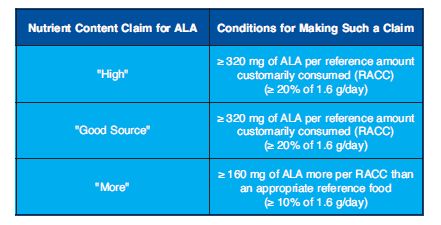Just when food manufacturers become familiar with labeling requirements, the U.S. Food and Drug Administration (FDA or the Agency) imposes new restrictions to implement. Recently, the FDA issued a final rule in the Federal Register that prohibits most nutrient content claims for foods that contain the omega-3 fatty acids docosahexaenoic acid (DHA) and eicosapentaenoic acid (EPA), as well as some claims for alpha-linolenic acid (ALA) (the Rule).1 The Rule finalizes a proposed rule published by the FDA back in 2007 without making any substantive changes to that proposal. Specifically, the Rule bans all statements on food product labels, including dietary supplements, that claim the product is "high in" DHA or EPA. Synonyms, such as "rich in" and "excellent source of," also are prohibited. Additionally, the Rule bans as "inherently misleading" certain statements that use the words "high" or "good source" or "more" to describe ALA in products. Prior to this Rule, the FDA permitted omega-3 nutrient content claims on food labels.
So what is the reasoning behind this Rule? Simply put, the FDA does not want nutrient content claims relating to omega-3 fatty acids to interfere with consumers' ability to understand the nutritional value of a food product.
Under the Federal Food, Drug & Cosmetic Act (FDCA), manufacturers and distributors may use a nutrient content claim—for example, "high in Vitamin C" or "low fat"—on a label to characterize the level of a nutrient in food or dietary supplements. The FDCA allows nutrient content claims only when a reference level for the claim has been established. No reference level has been set for DHA, EPA or ALA.
Between 2004 and 2005, several seafood and fish oil producers notified the FDA of their intention to make nutrient content claims for DHA, EPA and ALA on their product labels. Specifically, Alaska General Seafoods, Ocean Beauty Seafoods, Inc. and Trans-Ocean Products, Inc., a group of seafood processors, submitted the first notification to the FDA concerning nutrient content claims for ALA, DHA and EPA. Martek Biosciences Corp., a producer of nutritional supplements, submitted the second notification, proposing "high in" nutrient content claims for ALA, DHA and EPA. Finally, Ocean Nutrition Canada, Ltd., another nutritional supplement producer, submitted a third notification, proposing "high in" nutrient content claims for DHA and EPA. In notifying the FDA, these producers relied upon authoritative statements published by the Institute of Medicine (IOM) of the National Academy of Science, which identified nutrient reference levels for DHA, EPA and ALA, on which nutrient content claims could be based. Based on these authoritative statements, the notifications identified conflicting reference levels for DHA, EPA and ALA.
Because of these conflicting reference levels, the FDA determined that the IOM's statements upon which the DHA and EPA claims were based did not meet the requirements of the FDCA. In other words, the statements did not establish a reference level for DHA and EPA that could serve as a basis for setting a daily value for the nutrient. Consequently, the Rule bans all nutrient content claims for DHA and EPA. The Rule also prohibits nutrient content claims for ALA that the seafood processors proposed in the first notification. This ALA claim was based on a "population-weighted average" approach to establish a reference amount, which did not meet the FDCA requirements and did not allow consumers to understand the claim content in the context of a daily diet. However, the FDA will take no regulatory action on ALA nutrient content claims proposed by Martek in the second notification, as these claims were based on a "population-coverage" approach that is consistent with the approach the FDA has used to date.
While the Rule prohibits all DHA and EPA nutrient content claims, the FDA will allow the following ALA nutrient content claims to remain on the market:

This Rule will affect a wide variety of product categories labeled with omega-3 fatty acid claims. These products include, but are not limited to, seafood, pasta, eggs, milk, yogurt, cheese, butters, juices, packaged bread, fat-based spreads, meat from grass-fed animals, packaged meat, baby food, cooking oil, packaged soup, ice cream, nutritional bars and frozen pizza.
The Rule does not go into effect until January 1, 2016 to provide food manufacturers with a transition period. Food manufacturers with products that contain omega-3 fatty acid claims should review their labeling and marketing and promotional materials to determine whether it complies with the Rule. Manufacturers should not wait until the last minute to verify compliance because labeling changes can be costly and laborious, and may affect all parties up and down the distribution chain. Product inventory manufactured through December 31, 2015 is not affected by the Rule, but the FDA encourages manufacturers to use old labels before the compliance date.
Footnote
1 Food Labeling: Nutrient Content Claims; Alpha-Linolenic Acid, Eicosapentaenoic Acid, and Docosahexaenoic Acid Omega-3 Fatty Acids, 79 Red. Reg. 23,262 (proposed Apr. 28, 2014), available at http://www.gpo.gov/fdsys/pkg/FR-2014-04-28/pdf/2014-09492.pdf.
The content of this article is intended to provide a general guide to the subject matter. Specialist advice should be sought about your specific circumstances.


